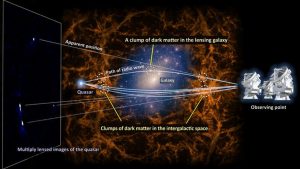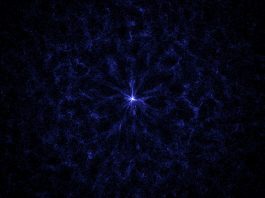New research has revealed the nature of dark matter in detail never seen before, down to a scale of 30,000 light-years.
The observed distribution fluctuations, made by a team at Kindai University, provide better constraints on the nature of dark matter.
Mysterious dark matter accounts for most of the matter in the Universe. It is invisible and only makes itself known through its gravitational effects.
The new research, ‘ALMA Measurement of 10 kpc Scale Lensing-power Spectra toward the Lensed Quasar MG J0414+0534,’ is published in The Astrophysical Journal.
What is dark matter and why is it important?
Dark matter, an unknown and invisible substance, makes up about 80% of our Universe.
Dark matter was postulated around 90 years ago to reconcile the velocity distribution of visible matter within galaxies.
However, scientists have never succeeded in observing it. It is known that it must exist, as without it, the motion of galaxies cannot be explained, and no experiments to date have been able to detect the nature of dark matter.
Using ‘natural experiments’ to reveal the nature of dark matter
The nature of dark matter has never been isolated in a laboratory, so researchers must rely on ‘natural experiments’ to study it.
One type of natural experiment is a gravitational lens. Sometimes by random chance, two objects at different distances in the Universe will lie along the same line of sight when seen from Earth.
When this happens, the spatial curvature caused by the matter around the foreground object acts like a lens. It bends the path of light from the background object and makes a lensed image.
However, it is difficult to achieve the high resolution needed to detect dark matter, so its exact nature has been poorly constrained.
To overcome these issues, the team used ALMA (Atacama Large Millimeter/submillimeter Array) to study the gravitational lens system MG J0414+0534.
In this system, the foreground object forms four images of the background object due to the gravitational force of a massive galaxy acting on the light.
The new constraints provided by the observed distribution are consistent with models for slow moving or cold dark matter.
In the future, the team plans to further constrain the nature of dark matter with additional observations.






